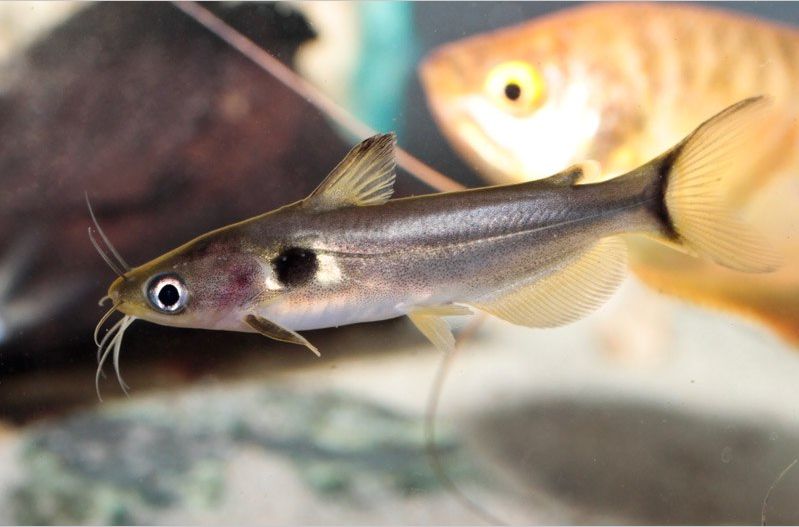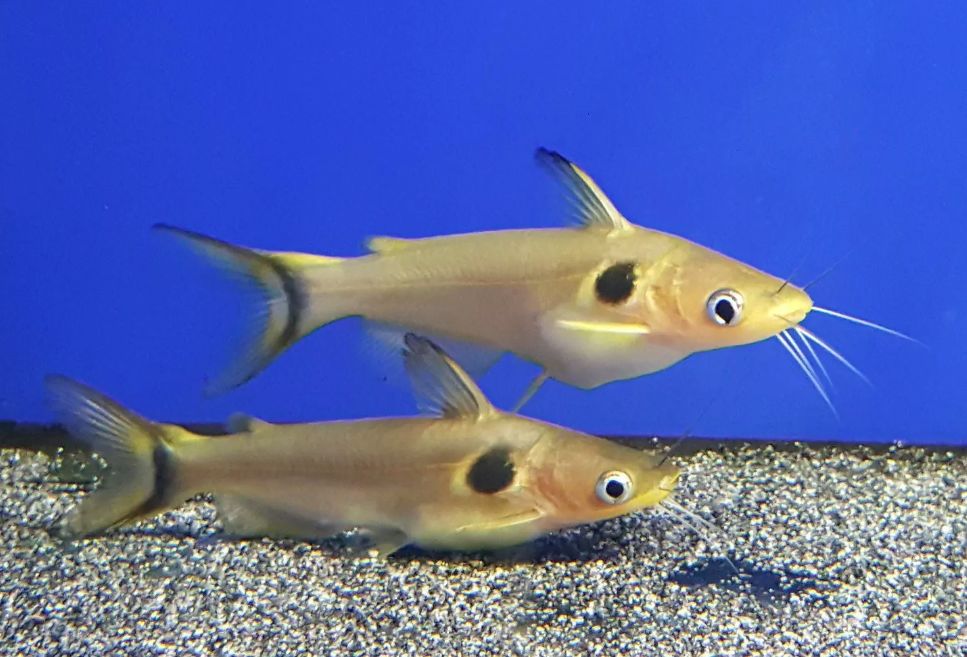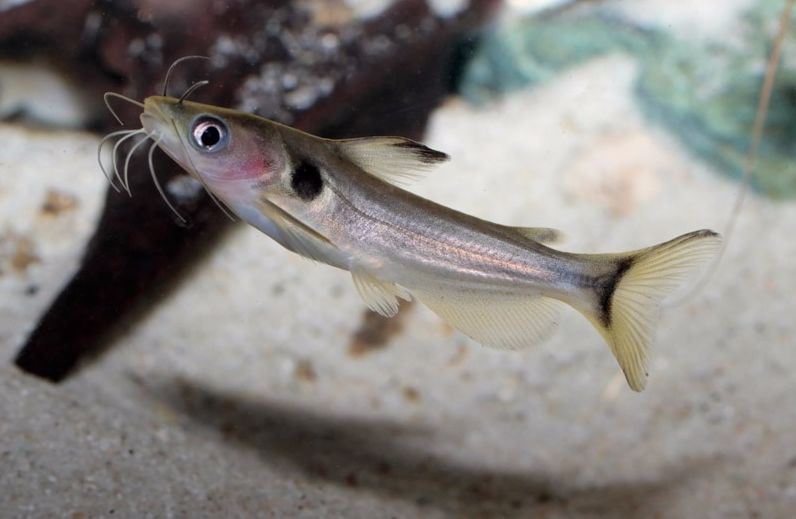The sun catfish (lat. Horabagrus brachysoma), which is also known as eclipse catfish, can often be seen in tanks nowadays, though it’s not a fish for everyone. This article has information about how large the fish can grow and who it represents danger to.

Contents
Habitat in the wild
Horabagrus brachysoma, also known as the sun catfish, is a species of freshwater catfish native to India. It belongs to the family Horabagridae, which is a small family of catfishes.
The sun catfish is endemic in Kerala state, India, and it dwells in Kerala backwater areas, in Vembanad lake, the Periyar and Chalakudy Rivers. The fish prefer thickly planted areas with slow water flow. As a rule, these are low-land river areas and backwaters with a muddy or sandy bottom.
Sun catfish preys on insects, mussels, and fish. Adult species of the fish can eat ground insects and even frogs. Having such a flexible diet is very convenient in the changeable life environment, where food availability depends on monsoon rains. It is known that the fish becomes more gluttonous during its spawning period and the months that follow the monsoon season.
| Scientific Name | Horabagrus brachysoma |
| Family | Bagridae |
| Common Names | Sun catfish, eclipse catfish |
| Range and habitat | India |
| Size | 45 centimetres (18 in) |
| Lifespan | 10 years |
| Ease of keeping | Easy |
| Minimum tank size | 50 gallons |
| Temperament | Predator |
| Diet | Omnivorous |
| Temperature | 73-77 °F (23-25 °C) |
| pH | 6.0-7.5 |
| Water hardness | 5-20 dGH |
Difficulties in keeping
It is an undemanding fish. However, it won’t do for community tanks. Firstly, this is a predator fish, which will prey on its tank mates. Secondly, the sun catfish becomes more active in the evening and at night, while it prefers hiding during the day.
Description
Body
This catfish has a large head and eyes, four pairs of barbs (on the upper and undertip, and in the corners of the mouth). Fish has a yellow-colored body with a large black spot near its pectoral fins.
Lifespan
The lifespan of the sun catfish (Horabagrus brachysoma) can vary depending on several factors, including environmental conditions, care, and genetics. In general, catfish species tend to have relatively long lifespans compared to many other freshwater fish.
Under optimal conditions and proper care in captivity, sun catfish can live for around 10 to 15 years or even longer. However, in their natural habitat, their lifespan may be influenced by various factors, including predation, availability of food, water quality, and human activities.
Size
It the internet, you may see the information that the sun catfish grows to be a small fish, about 13 cm long. Most aquarists think that this is a small-sized fish, but this isn’t true. In fact, the fish can grow up to 45 cm long in the wild, while in a tank, its size doesn’t exceed 30 cm (12 in).

Keeping in a tank
Tank size
The tank size required for sun catfish can vary depending on the age and size of the fish. Since sun catfish can grow to be around 10 to 12 inches (25 to 30 centimeters) in length, they require a spacious aquarium to accommodate their size and provide enough swimming space.
As a general guideline, a minimum tank size of 50 gallons (around 190 liters) is recommended for a single adult sun catfish. However, larger tanks are always better, and providing more space can improve the overall well-being and health of the fish.
Additionally, if you plan to keep multiple sun catfish in the same tank, you’ll need to consider increasing the tank size accordingly and provide ample hiding places and territories for each fish to reduce potential aggression.
Decor
It is a nocturnal fish, so you should provide it with dim light and lots of shelters in the tank (snags, small stones, flowerpots, and various tubes, etc.). Use caves, driftwood, and rocky formations to create hiding places where they can feel secure and reduce stress. Provide subdued lighting to mimic their natural habitat. Sun Ccatfish are primarily nocturnal, so bright lights can stress them.
Arrange the decor in a way that leaves open swimming spaces while providing enough sheltered areas. This setup allows the sun catfish to explore their surroundings while still having places to retreat.
Water Parameters
Recommended tank water parameters are the following:
- Temperature: Sun catfish prefer a relatively warm water temperature, ideally between 75°F to 82°F (24°C to 28°C).
- pH Level: The pH level should be kept in the slightly acidic to neutral range, around 6.5 to 7.5.
- Water Hardness: Sun catfish thrive in soft to moderately hard water. The recommended range for water hardness is between 5 to 15 dGH (degrees of General Hardness).
- Ammonia, Nitrite, and Nitrate: Ammonia and nitrite should be at undetectable levels, as they are harmful to fish. Nitrate levels should be kept below 40 ppm (parts per million) to avoid stress on the fish.
- Filtration and Water Quality: Adequate filtration is essential to maintain good water quality and keep ammonia and nitrite levels at bay. Regular water changes are also necessary to remove accumulated waste and maintain stable water parameters.
- Aeration: Sun catfish prefer well-oxygenated water, so providing adequate aeration and water movement is beneficial.
It’s essential to regularly test the water parameters using reliable test kits and make adjustments as needed to ensure a healthy and stable environment for your sun catfish. Always be cautious with any sudden changes in water parameters, as rapid fluctuations can stress the fish and compromise their health. Acclimating new fish to your aquarium slowly can help them adjust to the water conditions more effectively.
Diet
The sun catfish (Horabagrus brachysoma) is an omnivorous species, meaning it consumes both plant and animal matter. In the wild, their diet consists of a variety of small aquatic organisms found in their natural habitat.
Here are some common items in the sun catfish diet:
- Fish: It is a predator fish, so it prefers eating live fish.
- Insects: Sun catfish feed on various insects and insect larvae present in the water, such as mosquito larvae, small beetles, and aquatic bugs.
- Crustaceans: They may also consume small crustaceans like shrimp and small crayfish.
In captivity, it is essential to provide a well-balanced diet to ensure the health and vitality of sun catfish. A suitable diet can consist of high-quality commercial fish pellets or flakes specifically formulated for omnivorous catfish. Additionally, offering occasional live or frozen foods such as bloodworms, brine shrimp, or small pieces of fish can provide variety and essential nutrients.

Tank mates
This catfish quite often are sold as fish for community tanks, but actually, you mustn’t keep it in one tank with small-sized fish species. This catfish will eat everything that it can swallow; thus, its tank mates should be of the same size or even larger.
The best tank mates are large cichlids and other catfish species. Young species feel good in a company of their kind, and they even can create schools, while reproductive species of this catfish prefer solitude.
Here are some suitable tank mates for sun catfish:
- Bottom-dwelling Fish: Since sun catfish primarily inhabit the bottom of the aquarium, consider adding bottom-dwelling species like Corydoras catfish or other catfish species like hoplo catfish.
- Peaceful Cichlids: Certain peaceful cichlids, like blood parrot, can coexist with sun catfish if the tank size is appropriate and there are enough hiding spots.
- Peaceful Loaches: Certain loach species, like clown loaches, can make good tank mates, as they tend to be peaceful and occupy different levels of the aquarium.
When introducing new fish to the tank, it’s essential to monitor their behavior closely to ensure that there are no aggressive interactions. Avoid keeping sun catfish with larger or aggressive fish, as they may become stressed or intimidated.
Additionally, always consider the tank size and ensure it is large enough to accommodate all the fish comfortably. Providing plenty of hiding spots, plants, and driftwood will help create a more natural and stress-free environment for all the tank inhabitants.
Remember that individual fish may have unique personalities, so it’s essential to be observant and make adjustments if any compatibility issues arise.
Gender differences: male vs female
Distinguishing between male and female Horabagrus brachysoma can be somewhat challenging, especially when they are young. As they mature, subtle differences may become more apparent. The following are some general characteristics that might help differentiate between male and female sun catfish:
- Size: In some cases, males can be slightly larger than females, but this is not a reliable method of sexing them.
- Coloration: In some species of catfish, males may have brighter or more vibrant coloration than females, especially during the breeding season. However, this may not be as pronounced in all individuals or species.
- Papillary Organs (Genital Papilla): In mature fish, males may have a slightly pointed or more pronounced genital papilla near the anal fin, while females may have a rounder and less prominent one. However, this can be difficult to observe without experience or close examination.
It’s important to note that without specialized knowledge and experience, it can be challenging to accurately determine the sex of sSun catfish solely based on physical characteristics, especially when they are not in breeding condition. In some cases, expert fish breeders or ichthyologists may use dissection or other methods to identify the sex of adult fish more accurately.
Breeding
There is no valid information about successful breeding in captivity.